Doing the splits

While discussing the evidence that bees move eggs last week, I posed a simple question:
What do you think happens when you conduct a split, leaving one half suddenly queenless?
If you remember, I was discussing two studies by Mark Winston on the consequences of the sudden loss of the queen from a colony – either through ‘inadvertent ham-fistery’ by the beekeeper, or deliberately, for example when splitting a queenright colony in two.
Winston demonstrated that – in the absence of the queen – some previously empty queen cups were promptly populated with eggs, moved there by the workers. The eggs hatched, the larvae developed, the pupae pupated and – eventually – new queens emerged.
The purpose of the study was not to determine whether bees moved eggs, that was simply a serendipitous observation. Instead, Winston was primarily interested in the consequences for the colony of the sudden loss of the queen; how many queen cells are produced (after all, they only need one), what happens to the developing brood, do these queenless colonies swarm etc?
Since colony splits are a routine method used by many beekeepers to expand colony numbers, and ‘inadvertent ham-fistery’ is a feature of my beekeeping (even if not yours) I thought I’d discuss the additional results and conclusions of these studies by Winston.
Fortuitously, this also means I’ve already done the background reading for this post …
Splits
As far as I’m concerned, splitting a colony is any division of the resources of the colony; the adult bees, brood and stores.
The split could be 50/50, 70/30 or 90/10. The nucleus method of swarm control is a good example of a split, and you could refer back to that post for further details. A Pagden artificial swarm and some swarm control methods used when you cannot find the queen are also examples of splits.
Splits of various types are a routine beekeeping method.
Of course, preparing these sorts of splits involves a degree of ‘guesstimation’; you probably don’t measure the exact brood area, but instead just count the number of frames containing brood.
You might also ignore whether the brood frames are uncapped larvae, or emerging workers, though this has a significant impact on the worker population in the 1-2 weeks following the split.
And that’s before you take into account returning foragers that go back to the original location, rather than remaining in their new abode, or the significant loss of brood following the split.
The loss of brood?
I’ll return to that shortly.
Queens and superposition
Superposition is a feature of quantum mechanics where a subatomic particle exists in all possible states simultaneously … until you try and observe them.
Queens are not subatomic, even the tiny little runty ones, though they could be anywhere but on the frame you’re looking at when you need to find them in a hurry.
It’s only Schrödinger’s cat that can be in two places simultaneously. In contrast, queens ignore the laws of quantum mechanics and can only occupy a single state (alive or dead) or location.
Therefore, a queenright colony split into two will generate one queenright box and one queenless box.
Unless the queen gets killed in the process, through ‘inadvertent ham-fistery’ or – in the case of a few colonies with a new queen – being balled by the workers {{1}}.
So, in normal circumstances, a 50/50, 70/30 or even 90/10 split of a queenright colony will result in one of the resulting ‘halves’ needing a new queen.
‘Strength’ or otherwise of splits
Weak colonies should not be split.
If there are too few bees and brood present, splitting them could leave you with two colonies of borderline viability.
Let’s assume for the rest of this post that you didn’t or couldn’t find the queen, and so split the original strong colony about 50/50.
Assuming you provisioned both new colonies with eggs and young larvae, the workers in the queenless ‘half’ will select specific eggs/larvae, draw out queen cells (possibly after moving eggs to vacant queen cups), and rear one or more new queens.
This post is about that part of the process; the generation of queen cells and the queens that emerge, the fate of the brood in the colony, the eventual fate of the colony and the time it all takes.
If you do go to the trouble of finding the queen before preparing the split, the logical thing to do is to bias the split – in terms of resources allocated to it – in favour of the queenless ‘half’. For example, you might allocate only 30% of the brood to the queenright colony, reasoning that the queen will continue laying and will rear lots more brood.
Whatever the precise proportions, the description of what happens next is likely to be broadly similar.
The experiments
Winston conducted his studies in Langley, British Columbia (49°N) using Apis mellifera carnica or A. mellifera ligustica colonies (Punnet & Wilson, 1983). He had conducted similar studies using Africanised bees in French Guiana (5°N) a few years earlier (Wilson, 1979).
I’ll focus largely on the studies using Apis mellifera as, a) the results are broadly comparable, and it will avoid repetition , and b) most readers will probably not have Africanised bees. Unless otherwise stated, I’ll pool the results from the 8 colonies used (four of each subspecies; there were no significant differences between them), or state average numbers of whatever (queen cells, queens, cm2 of brood etc.).
Queenless colonies were prepared using frames containing brood in all stages plus the adhering bees, nectar honey and pollen. The prepared colonies were reasonably strong (8 frames in a Langstroth medium brood box), but no more so than a split double-brood National hive.
Colonies were inspected daily, recording queen cell number, position, age, fate of the occupant and brood area. Newly emerged queens were marked with a unique label and any swarms recorded.
Worker brood mortality was calculated by recording the area of unsealed brood on day 0, and the area of sealed brood 13 days later. Since brood is sealed for 13 days, the difference between these numbers indicates the amount of unsealed brood which was not successfully sealed; this is worker brood mortality.
Queen cells
Within one day of being de-queened, colonies started rearing new queens under the emergency response. On average, colonies produced ~15 viable queen cells (i.e. from which a queen eventually emerged) each, together with a further ~20 that were started (i.e. charged and drawn out) but subsequently destroyed before the first queen emerged. In addition, numerous additional queen cups (~30 per colony) were prepared but remained unoccupied.
That’s a lot of queens and queen cells …
The number of queen cells was unrelated to the strength of the colony, or at least the brood area, as the worker population was not quantified. The brood area in the second strongest colony was almost double that of the weakest, but these two colonies produced the smallest number of viable queen cells (5 and 7, respectively).
One colony produced 28 viable queens.
Under the emergency response, bees prefer to rear queens from eggs. In fact, 90% of the viable queens reared were eggs at the time of de-queening, with the remainder being day-old larvae. Many of the queen cells that were eventually torn down were probably started late from older larvae.
There appeared to be no marked preference in terms of queen cell location. They were more or less evenly distributed over the frames, though somewhat less numerous nearer the hive entrance (remember, Langstroth hives are all ‘cold way’, with the end bars of the frame adjacent to the entrance).
Queens and swarms
On average, queens emerged 8.4 days after the cell was sealed, taking 15.7 days to develop from egg to adult. No real surprises there.
The majority of the viable queens emerged over a relatively short period. All were marked, but the fate of individual queens could not always be determined as multiple queens emerged on each day.
Most colonies appeared to contain only a single queen at any one time, but two contained two and one had three queens at one inspection. At the end of the study, all the colonies were queenright.
So where did all those queens go?
Some were killed by the colonies and others left when the colony swarmed.
75% (6/8) colonies swarmed between 4 and 10 days after the first queen emerged. There’s no mention of the weather conditions, so I don’t know if some colonies may have been held back by environmental conditions.
Perhaps you are not surprised at the number of swarms, considering the number of queens?
However, remember that these queens were all reared under the emergency response, not in response to overcrowding or lowered levels of queen pheromones that would typical induce a reproductive swarming response.
Some of the swarms were captured and all contained multiple queens (either 2 or 3).
Additional queens continued to emerge for up to four days after swarming had occurred in a colony, with remaining cells being torn down during the same period.
Brood and new brood
The two most notable observations of the entire process relate to the amount of viable brood in the colony lost during requeening (brood mortality), and the total time it took from de-queening until there was a new, laying queen in the colony.
Not only are they the most notable observations, they are also the easiest to describe.
Brood mortality was high in de-queened colonies. On average, 44% of unsealed brood present when the queen was removed was lost before the brood cells were capped. This loss would have all occurred within the first fortnight after removal of the queen.
However, colonies didn’t contain a laying queen until a further fortnight had elapsed. On average, it took 29 days from ‘start to finish’ before colonies contained a new laying queen.
Africanised bees
I’m going to ignore most of the (generally minor) differences between these Apis mellifera studies and the earlier study of Africanised bees by Winston.
The only really significant differences were in the duration of period between queen removal and when the new queen started laying. In Africanised bees this was ~23 days, 6 days shorter than Apis mellifera.
This was attributed to:
- Africanised queens had a mean development time of 14.6 days (pupation was 1.1 days shorter)
- Swarming (if it occurred) and the time taken for a queen to mate and start laying was 5 days less for Africanised bees.
Surprised?
The experiments described above were straightforward; no mind-numbing statistics, no inexplicable principal component analysis and no ‘big data’ genetic heatmaps that obscure as much as they show.
But that doesn’t make them uninteresting, and it certainly doesn’t mean that they aren’t very relevant to practical beekeeping.
Queen-loss swarming, swarms and casts
The first big surprise, at least to me, was the frequency of swarming observed when requeening.
Winston calls this queen-loss swarming. This is distinctive from reproductive swarming … or as we usually call it ‘damn I missed a queen cell’ swarming.
What are the main differences?
Reproductive swarming involves the production of queen cells prior to the laying queen leaving. It also usually involves colony overcrowding. In contrast to reproductive swarming, queen-loss swarming is characterised by a protracted period of queenlessness before the swarm issues.
In fact, queen-loss swarming looks more like cast production or afterswarming. A cast is a swarm headed by a virgin queen that leaves the colony several days after the prime swarm issues (headed by the original mated queen).
Why swarm anyway?
Why do these de-queened colonies swarm?
It seems counterintuitive.
The colony is not overcrowded. Surely it would surely be better to keep the colony together, wait for the queen to get mated and build up strongly again? By swarming, the colony is further reduced in strength and the size of the queen-loss swarm is probably insufficient for successful overwintering.
Consider other events that involve queen replacement. If the colony is overcrowded, it swarms reproductively. The resulting swarm may not survive (~25% survival rate), but the parental colony has a high chance (>80%) of successfully requeening.
If the queen is (f)ailing the workers rear a few supersedure queens {{2}}, the queen is quietly replaced – perhaps with a prolonged transition period when both queens lay eggs – and the colony does not swarm.
In contrast, the sudden loss of the queen is probably an unusual event for a colony. Other than a ham-fisted beekeeper it’s difficult to think how it could occur. Disease possibly? {{3}}
If it’s a very rare event then it is likely that evolution hasn’t achieved an effective way to deal with it.
Instead, I suspect the colony are responding to the same set of triggers that induce afterswarming or the production of cast swarms in a strong colony; no laying queen present and/or a protracted period without a queen before swarming.
Maybe they’ve got no choice in the matter …
Brood loss
The other big surprise to me was the large amount of brood loss (~44%) experienced by colonies after removal of the queen.
If you assume that the queen was steadily laying 1500 eggs per day there would be 3 times that number of eggs and 5 times that number of pupae in the colony (because eggs hatch after three days and larvae pupate a further five days later) on the day she was ‘removed’.
44% of 12,000 is a lot (>5000) of future workers. Their loss will hold the colony back, particularly when you remember that the colony will have no laying queen for 29 days and so will not produce new workers (i.e. from the new queen) until 50 days have elapsed since the loss of the queen.
It’s not clear how the brood is lost.
The loss occurs well before swarming occurs, and probably happens before the worker population is reduced significantly through natural losses. I therefore suspect the brood is cannibalised as an evolutionary protection mechanism to avoid depletion of stores (Schmickl and Crailsheim, 2001).
Afterswarming is also characterised by high levels of brood loss, possibly for the same reasons.
Implications for practical beekeeping
I think that these simple observational studies, conducted over 40 years ago, have a number of implications for practical beekeeping.
Simply splitting a strong colony will result in one ‘half’ losing a large amount of its open brood, experiencing a protracted queenless period and – in most cases – swarming.
These three events all weaken the colony.
If the split is being conducted to increase colony numbers, it is largely self-defeating. Why use a method that significantly weakens – albeit temporarily – one of the resulting colonies?
Rather than splitting a colony and letting the bees determine what happens and when it happens, here are some better options …
Requeen queenless splits
Rear your own queens and use these to requeen the queenless ‘half’ of the split. Queens can be introduced when mated, as virgins or in a close-to-emergence mature queen cell.
Simply adding a mature queen cell (either reared by your own fair hand, or from a colony making swarm preparations) will reduce the duration with ‘no laying queen’ from ~29 days to ~13 days. It will also prevent production of new queen cells and reduce the chance that the colony swarms.
A mated queen will reduce this period to just a couple of days.
The sooner the split contains a new laying queen, the faster it will return to full-strength, so becoming more productive and better able to cope with adverse events (e.g. bad weather, pathogens, wasps or robbing bees).
Manage splits properly
If you have no spare queens and still split (or de-queen) your colony – either deliberately or through ‘inadvertent ham-fistery’ – then it makes sense to do the following:
- Reduce queen cell numbers to just one a few days after removing the queen. You can (and should) trust the choices that the bees make … they have had millions of years to hone the critical decision of choosing the ‘best’ larvae to ensure survival of the colony. This will stop swarming.
- Populate the de-queened ‘half’ of a split with good amounts of sealed and emerging brood, rather than eggs/larvae … though they will need some eggs to use to rear new queens. Winston suggests supplementing the queenless ‘half’ with emerging brood from another colony, but I’d prefer not to weaken other colonies unless they really can spare the brood. This brood redistribution will help reduce loss of open brood (possibly through cannibalism) and will compensate for the loss of older foragers through old age and disease.
- If both ‘halves’ of the split remain in the original apiary you may need to re-balance the worker population as most will return to the original location.
Not doing the splits
A ‘Walk away split’ might sound easy, but that doesn’t mean it is efficient or particularly good practice. As with many beekeeping methods, it is probably better in some locations than others. Long seasons, good nectar flows and prolific bees probably all help.
I favour the nucleus method of swarm control. It’s a split, perhaps 70/30 or 80/20, with enough bees to keep the queen safe and the majority remaining in the original hive. Done properly and at the right time of the year it’s very dependable – both in preventing swarming and getting a colony requeened.
However, given the choice, I’d almost always prefer to requeen the colony directly with a mature queen cell, a virgin or mated queen. This short-cuts the production of a new queen by the colony, improves the quality of the bees {{4}}, ensures ample time to build up to full strength for the summer nectar flow and – although it seems a long way off at the moment – the winter ahead.
Notes
Of course, I’ve made up the term ‘inadvertent ham-fistery’. Being ham-fisted means …
Having large or clumsy hands, heavy-handed, awkward; bungling.
… which makes perfect sense if you know what a ham looks like, and – not coincidentally – is a perfect description of the worst of my beekeeping.
If you’re sick of the eejits, trolls, fascists, communists, anti-vaxxers, conspiracy theorists, bots and Elon Musk on Twitter, come and join me on BlueSky. It’s a lot more civilised, not least because there are only 34 registered accounts at the moment. New post announcements also appear on Mastodon and Instagram. I don’t use social media for discussions … if you want an actual response you may be disappointed 🙁
Finally, comments and new registrations to this site will probably be turned off sometime on the week of the 4th of March to switch to a new server. The website address will remain the same, so please go there if you don’t get an email next Friday afternoon.
Thank you
References
Punnett, E.N., and Winston, M.L. (1983) Events following queen removal in colonies of european-derived honey bee races (Apis mellifera). Ins Soc 30: 376–383 https://doi.org/10.1007/BF02223969.
Schmickl, T., and Crailsheim, K. (2001) Cannibalism and early capping: strategy of honeybee colonies in times of experimental pollen shortages. J Comp Physiol A 187: 541–547 https://doi.org/10.1007/s003590100226
Winston, M.L. (1979) Events following queen removal in colonies of Africanized honeybees in South America. Ins Soc 26: 373–381 https://doi.org/10.1007/BF02223556.
{{1}}: Which might be classified as inadvertent ham-fistery because you should have known something about the box you were splitting.
{{2}}: Often just one.
{{3}}: I’m open to suggestions.
{{4}}: Since you only rear queens from good colonies.
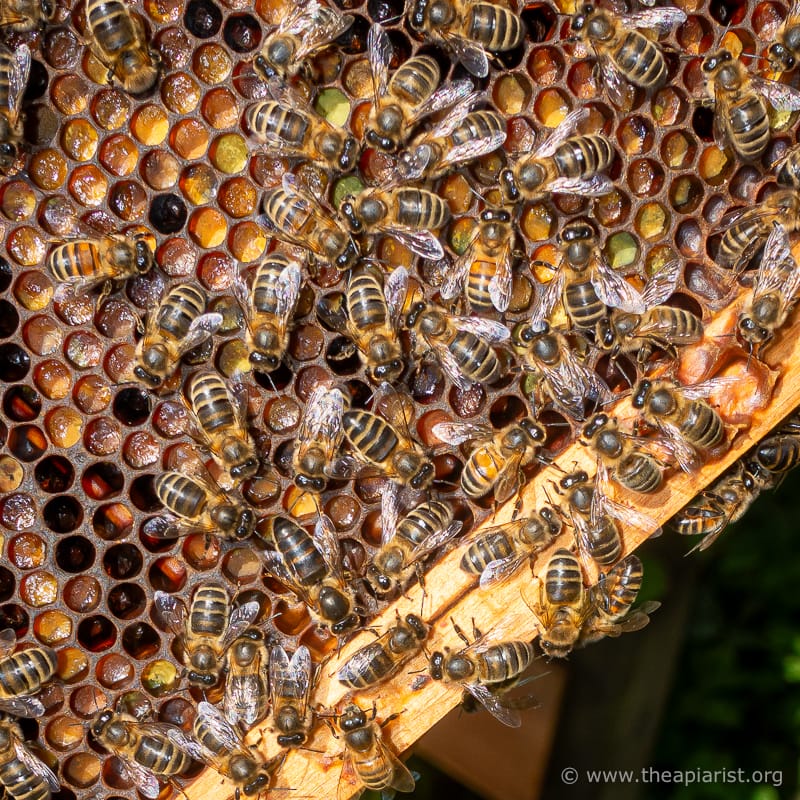
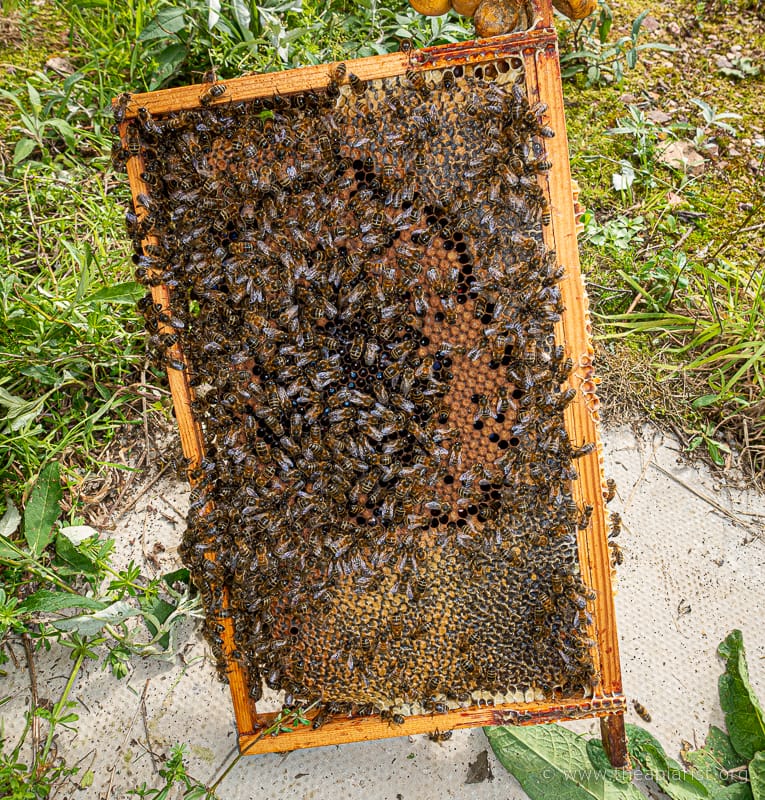
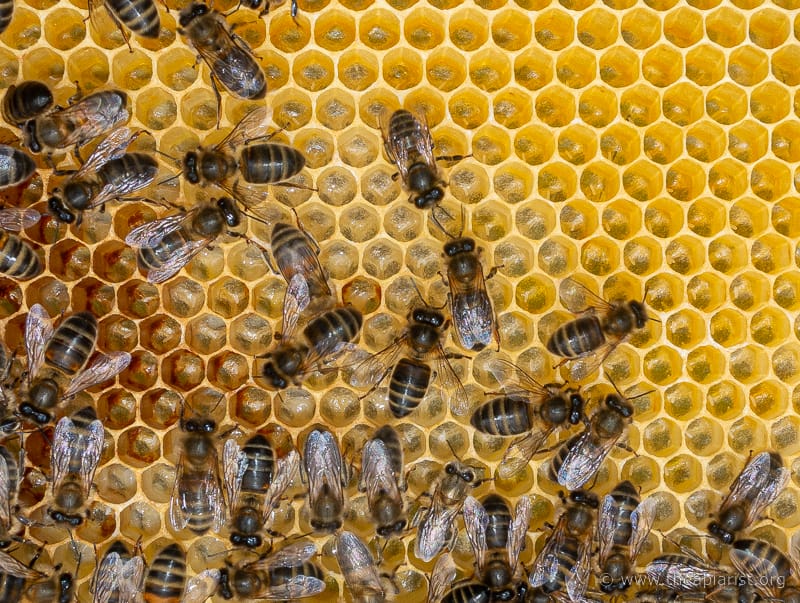
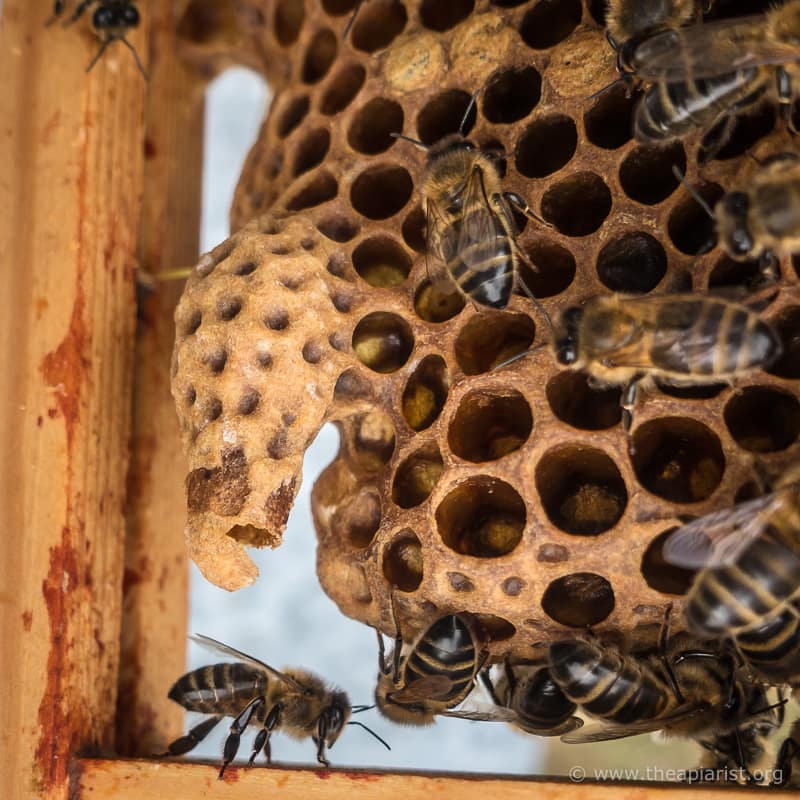
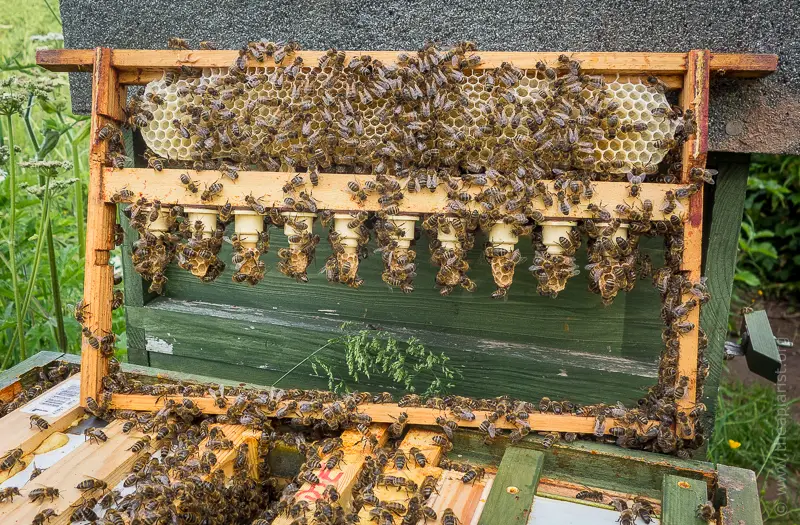
Join the discussion ...